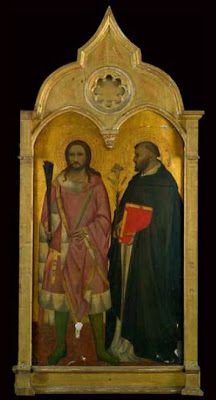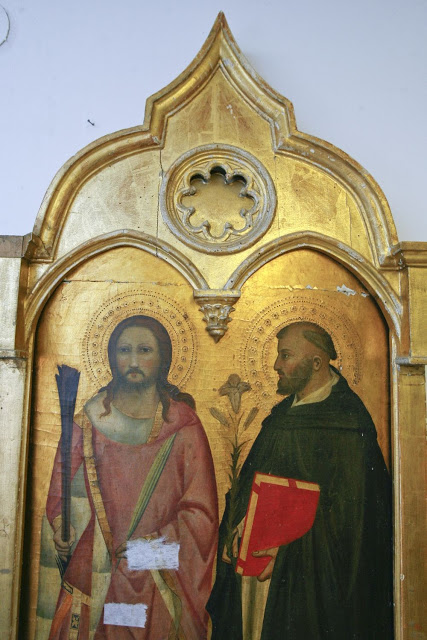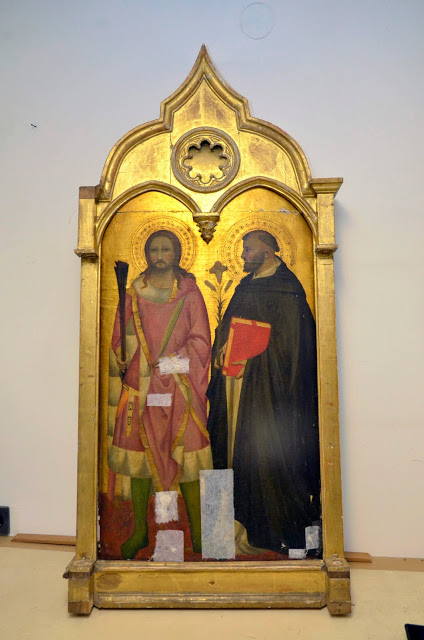Medieval History

- Stolen 14th-century Italian Painting Found In The United States
A 14th-century triptych painting, which was stolen from an Italian villa nearly 40 years ago, has been found in a museum in Kentucky. US government officials announced yesterday that the art piece, a three-panel wooden triptych, which depicts the Virgin...
- Collected Studies Of András Péter Published
Last December marked the 70th anniversary of the death of art historian András Péter. He was a noted scholar of Italian Trecento painting, as well as of Hungarian medieval art. Born in 1903, he studied in Budapest and defended his doctorate in 1925....
- Once More On "botticelli In Esztergom"
It has recently been stated by the Hungaarian government that new financial sources have been provided for the completion of the restoration of the medieval castle complex in Esztergom, in particular that of the early Gothic castle chapel and the adjoining...
- First Publications On The Murals Of The Parish Church Of Pest
The 14th century fresco of the Virgin of Child, discovered last year in the sanctuary of the Inner City Parish Church of Pest (in downtown Budapest) created quite a stir. I suppose it always creates some stir when a a fresco appears older than the wall...
- The Secret Of The Casket
Photos by Melange Galéria, Budapest A small Italian Renaissance casket went on display earlier this month in a Budapest gallery. The display was opened by Mária Prokopp, university professor and a noted expert of Italian Renaissance painting. So...
Medieval History
Italian Trecento Panel Discovered in Hungary

A previously unknown Italian Trecento panel painting went on display today at the Damjanich János Múzeum at Szolnok. The exhibition was opened by Mária Prokopp, Professor Emeritus at Eötvös Loránd University, a noted expert of early Italian painting. Dr. Prokopp provided the following information about the panel to the Medieval Hungary blog:
The panel was discovered in 2010 by the art historian of the Szolnok Museum, László Zsolnay, at the parish church of Kunhegyes. He was able to trace the history of the painting, which comes from a small chapel near Kunhegyes, at Tomajpuszta. This Neo-Gothic chapel has been erected by the Nemes family, and was completed in 1892. The Trecento panel was donated to the chapel around 1900. It stood there until 1945 - after which the chapel was sacked and fell into ruin. From the furnishings of the chapel, only this altarpiece was saved, which was taken to Kunhegyes and forgotten - until it was found by Zsolnay. On the back of the panel, there are two seals proving the legal export of the panel from Italy and its origin from Florence. It was established that the panel comes from the church of Santa Maria a Ricorboli in Florence. Ricorboli is now a suburb of Florence, just south of the Arno. The medieval church there was demolished around 1900, and its original furnishings were sold at the time, to raise money for the new church, built between 1906-1926 (which today still preserves a panel painting of the Virgin and child, attributed to Giotto and his workshop).
 |
| Trecento panel from Kunhegyes - Photo by Magyar Nemzet, mno.hu |
The panel painting is the right section of a large polyptych, in a modern (Neo-Gothic) frame, and depicts two saints. The one on the right, facing towards the center of the former altarpiece, is St. Dominic. The other saint is a knight, who has been tentatively identified by dr. Prokopp as St. Nemesius, while László Zsolnay proposes that he represents St. Sebastian (with a bunch of arrows in his hand). Other parts of the altarpiece have so far not been identified. It is quite clear that the painting comes from the circle or workshop of Andrea Orcagna, the leading master in Florence after the Black Death of 1348. Mária Prokopp proposed a possible attribution to Jacopo di Cione, while Angelo Tartuferi, curator of medieval art of The Uffizi attributed it to Giovanni del Biondo, when asked by Zsolnay (Tartuferi has since become the new director of the Galleria dell'Accademia). However, the current condition of the painting makes the task of attribution difficult.
The painting will be on display at Szolnok until the end of Szeptember, after which it will be taken to Eger, to be incorporated into to the Ecclesiastical Museum (the parish church of Kunhegyes belongs to the Archibishopric of Eger). Hopefully, the panel will be restored soon, after which its attribution and dating can be settled and of course further research can be carried out about its origins.
 |
| The panel, as shown to the press before going on display. Source: mti.hu |
In addition to information received from Dr. Prokopp, I also relied on an article published yesterday in a Hungarian daily newspaper, Magyar Nemzet. More photos are also available here.
- Stolen 14th-century Italian Painting Found In The United States
A 14th-century triptych painting, which was stolen from an Italian villa nearly 40 years ago, has been found in a museum in Kentucky. US government officials announced yesterday that the art piece, a three-panel wooden triptych, which depicts the Virgin...
- Collected Studies Of András Péter Published
Last December marked the 70th anniversary of the death of art historian András Péter. He was a noted scholar of Italian Trecento painting, as well as of Hungarian medieval art. Born in 1903, he studied in Budapest and defended his doctorate in 1925....
- Once More On "botticelli In Esztergom"
It has recently been stated by the Hungaarian government that new financial sources have been provided for the completion of the restoration of the medieval castle complex in Esztergom, in particular that of the early Gothic castle chapel and the adjoining...
- First Publications On The Murals Of The Parish Church Of Pest
The 14th century fresco of the Virgin of Child, discovered last year in the sanctuary of the Inner City Parish Church of Pest (in downtown Budapest) created quite a stir. I suppose it always creates some stir when a a fresco appears older than the wall...
- The Secret Of The Casket
Photos by Melange Galéria, Budapest A small Italian Renaissance casket went on display earlier this month in a Budapest gallery. The display was opened by Mária Prokopp, university professor and a noted expert of Italian Renaissance painting. So...
